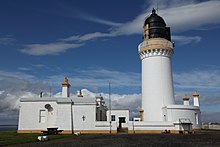Noss Head Lighthouse

Noss Head in 2011
|
|
|
Highland
|
|
| Location |
Wick Highland |
|---|---|
| Coordinates | 58°28′44″N 3°03′03″W / 58.479°N 3.0509°WCoordinates: 58°28′44″N 3°03′03″W / 58.479°N 3.0509°W |
| Year first constructed | 1849 |
| Construction | masonry tower |
| Tower shape | cylindrical tower with balcony and lantern attached to 1-storey keeper's house |
| Markings / pattern | white tower, black lantern, ochre trim |
| Height | 18 metres (59 ft) |
| Focal height | 53 metres (174 ft) |
| Range | 25 nautical miles (46 km; 29 mi) |
| Characteristic | Fl WR 20s |
| Admiralty number | A3544 |
| NGA number | 114-3012 |
| ARLHS number | SCO-157 |
| Managing agent | Northern Lighthouse Board |
The Noss Head Lighthouse is an active 19th century lighthouse near Wick in Caithness in the Highland council area of Scotland. It is located at the end of Noss Head, a peninsula on the north-west coast of Caithness that overlooks Sinclairs Bay three miles north-east of Wick. It is notable as being the first lighthouse that was built with a diagonally paned lantern room.
The need for the lighthouse was promoted by the Northern Lights Commissioners, and the light first entered service in 1849, and consists of an 18-metre-high (59 ft) cylindrical tower, which is painted white. It supports a single gallery and a lantern with a black cupola. There are 76 steps to the top of the tower. Adjacent to the tower are a pair of keeper’s cottages and subsidiary buildings, bounded by a walled compound.
The lighthouse was built by Mr. Arnot of Inverness, with the construction being overseen by the notable lighthouse engineer Alan Stevenson (uncle of Scottish author Robert Louis Stevenson), who for the first time used diagonal glass panes and framing for the exterior lantern. Considered to be both stronger, and less likely to interrupt the light from the optic, the design was employed as the standard for all future lighthouses built by the Board.
As a way to provide work for those local people who had been affected by the Highland potato famine, and needed Poor Relief, labourers were hired at a rate of 3s/6d per day (£15 as of 2017) to construct an access road from Wick to the lighthouse.
In 1987 the light was converted to automatic operation, and the keeper’s cottages were sold and are now used by the Clan Sinclair Trust as a study centre for research into the clan's history. The main keeper’s house and one of the cottages have also been converted to holiday accommodation.
Following automation, the original Fresnel lens and mechanical drive train from the lighthouse were removed and are now exhibited on two floors of the Wick Heritage Centre, one of the few lens and drive train from this period that are still in full working order.
...
Wikipedia

